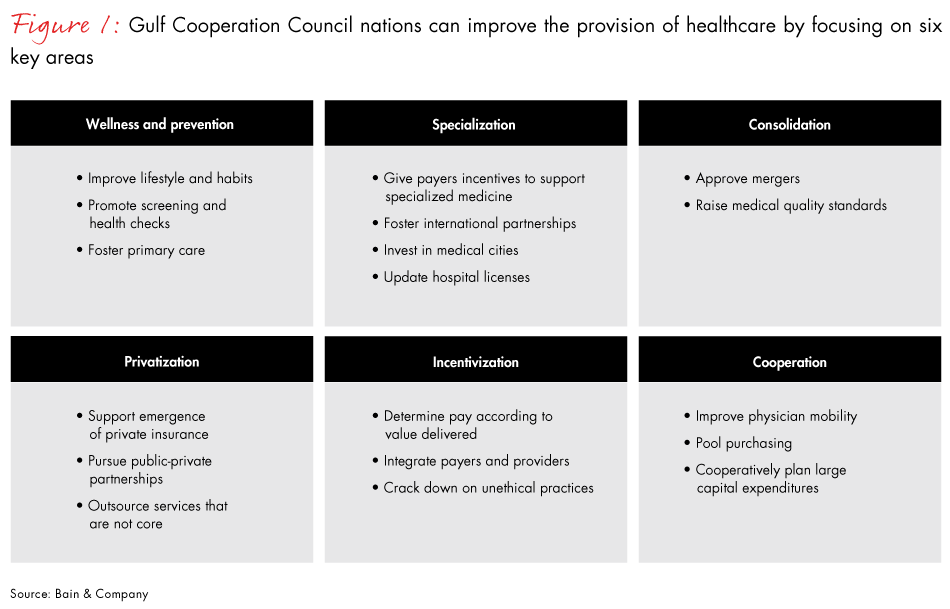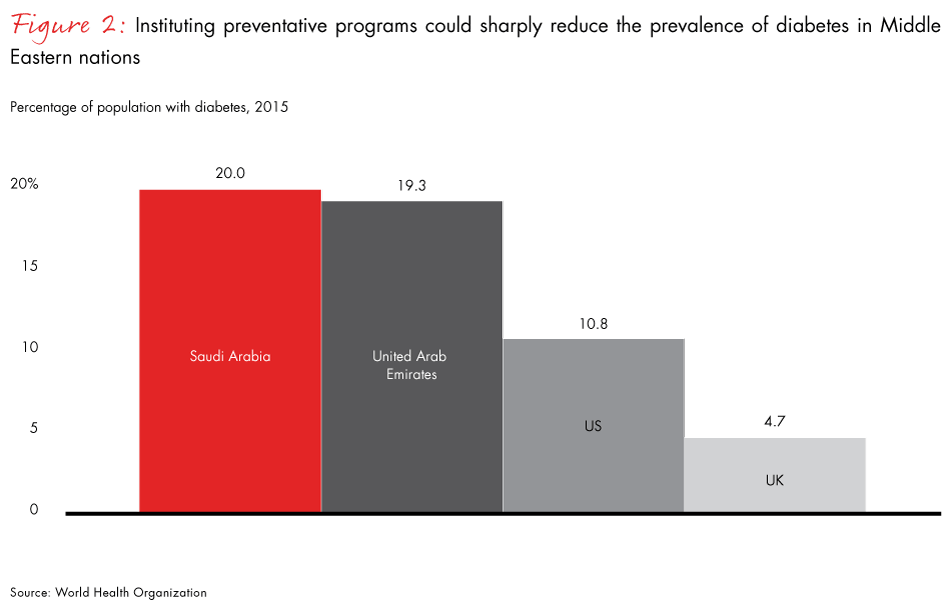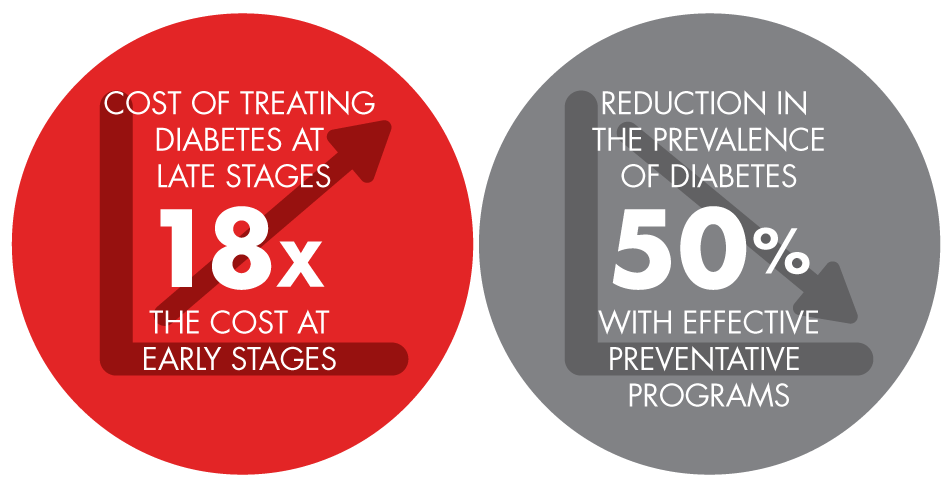Brief

Over the past decade, healthcare has undergone a massive transformation in many of the member countries of the Gulf Cooperation Council (GCC) and has improved during that time. Insurance has become mandatory for many GCC residents, and in many countries, the level of care available has improved markedly.
Yet significant challenges remain in several areas, including access, quality, cost and funding.
Access. Overall, access to medical care has improved in the council states, but some gaps remain. Attracting and retaining medical talent is still difficult. The UK has 8.4 nurses per 1,000 inhabitants, and the US 9.9. By contrast, there are just 3.1 nurses per 1,000 inhabitants of the United Arab Emirates (UAE), and 5.2 in the Kingdom of Saudi Arabia (KSA). Scarcity of specialized facilities is also an issue. For example, tertiary care hospitals that offer deep medical specialization represent only an estimated 20% of private-sector beds in the two largest cities in the KSA. Another example is the lack of specialized long-term care facilities in the GCC; patients who would be better off in long-term care facilities occupy an estimated 20% to 30% of public hospital beds. In the UAE, which has started addressing the issue, this share is lower, but still high at around 10%.
Quality. The outcome of care compared with spending in the GCC is below that of equivalent health systems in other regions, according to the Economist Intelligence Unit. Quality of primary and secondary care is uneven, while the quality of tertiary and quaternary care, which is in short supply as mentioned above, often remains substandard. To compensate for this lack of specialized services, governments send many patients abroad for treatment of complex cases, mainly oncology, orthopedics, trauma, rehabilitation and pediatric services.
Cost. Issues of access and quality result in unnecessary waste for local governments. Estimates of GCC spending on medical travel, for instance, are as high as $20 billion a year. Similarly, the cost of patients who need long-term care but instead reside in general hospitals is significantly higher than if they were in a long-term care facility. This is a crucial issue, since government budgets are under pressure while demand for healthcare continues to rise, driven by population growth, aging populations and increasing prevalence of chronic diseases.
Funding. Private-sector payers and providers remain relatively underrepresented. GCC governments pay on average for 70% of all healthcare, spending that represents a material portion of government budgets. Funding this healthcare bill is increasingly challenging in the current environment of lower oil prices and reduced government budgets. Given this “new normal” for the GCC, governments might be tempted to impose a copay so aggressive that it would deprive the public of access to critical services, or to reduce reimbursement rates to institutions, a step that could discourage the kind of investment needed to address gaps in quality and access.
Six key areas of focus
Synthesizing the experience of healthcare providers, payers and regulators both in the region and from more mature markets, we highlight six areas that can be tackled in order to build scenarios that benefit all participants: payers, providers and patients (see Figure 1).

Wellness and Prevention. Prevention and early diagnoses are widely recognized as effective levers to reduce healthcare cost and improve clinical outcomes. Today, however, GCC countries spend only $31 to $131 per capita per year on preventive care. That compares with roughly $400 to $500 per capita in Western countries such as France, Germany and the Netherlands.
Diabetes is an example of a common illness in the GCC that could benefit from prevention and early diagnosis. The prevalence of diabetes in the GCC is among the highest in the world, according to the World Bank. GCC countries have diabetes rates as much as 2 ½ times the world average (see Figure 2). The cost of treatment of diabetes at a later stage, when complications are more likely, is 18 times higher than early treatment. An effective preventative policy can reduce the number of people living with the disease by 50%, and reduce total diabetes costs by 25%.

In the US, early diagnosis has proven to be less expensive and more effective with other diseases as well, reducing the cost of cervical cancer treatment by 40% and doubling the survival rate; reducing the cost of kidney disease 75% while improving the survival rate eight times; and lowering the cost of chronic artery diseases by 85% while doubling the survival rate.
On wellness and prevention, three priorities emerge for GCC countries. Some are already in place in certain countries and could be rolled out to others:
- Improve lifestyle and eating habits. One way to do that is by promoting sports. The region already has a private fitness sector, and governments are beginning to take notice of this opportunity. In its Vision 2030 plan, the KSA committed to increase the percentage of individuals exercising at least once a week to 40% from 13%. It is also important to encourage healthy eating. The UAE has already taken a step in this direction with its plan to require restaurants to show customers the calorie information of dishes they serve. Financial incentives can be effective as well. GCC countries have imposed or are planning to impose special taxes on unhealthy products such as tobacco and soda. The tactic has proven to be one of the most effective tools for reducing tobacco consumption in Western markets, with a 10% price increase due to such taxes reducing usage by volume as much as 5%, the World Health Organization said.
- Promote screening and health checks. Regulators can combine communication and financial incentives to encourage early screening programs like those for breast cancer detection. All payers, insurance companies and employers could cover diagnostic evaluations for their employees. In some markets, health-check packages promoted by private-sector diagnostic laboratory chains have become increasingly popular.
- Foster primary care. By using general physicians as the gatekeepers for specialist services, most countries have successfully reduced costs and improved anticipation of medical issues before the acute stage. In the KSA, where the absence of strong infrastructure has led to overuse of Ministry of Health hospitals, primary care is being fostered through privatization. Policies that enforce use of primary care resources first can help, too. The adoption of remote monitoring solutions by payers, as global insurer AXA is doing with its wearable technology in Europe and other markets, can also support a focus on primary care providers and prevention.

Specialization. Historically, the region has rightfully focused on developing capacity and access, with both public and private providers concentrating on improving access to secondary care generalist hospitals, and, to a lesser extent, to primary care. As a result, generalists dominate across the GCC, with little specialization in format, medical specialty or segmentation. Increased specialization, however, would provide many proven benefits, among them: lower cost of care, a reduction in costly outbound medical tourism, improved outcomes and local talent development.
In many parts of the GCC, there is a shortage of good-quality, specialized formats such as long-term care, rehab, mental health facilities, women’s and children’s hospitals, geriatric hospitals or home healthcare providers. Most private hospitals offer secondary care specialists, but few offer the specialized equipment and expertise of a tertiary hospital, or the experimental medicines and procedures and specialized surgeries of quaternary centers. For example, only 20% of private hospital beds are truly tertiary care in the two largest cities in the KSA, while in advanced markets, private hospital groups often become “centers of excellence” focused deeply on two or three specialties.
From a business perspective, there is limited market segmentation, with most private hospitals unable to calculate their cost of services and allocate resources to various patient segments.
On specialization, four priorities emerge for GCC countries:
- Create payment schemes—public, insurance-based or corporate—that give private investors incentives to support specialized formats.
- Foster partnerships with Western institutions to help transfer knowledge and gain access to star doctors. Examples of such cooperation include programs with the Cleveland Clinic, Johns Hopkins University, and King’s College London.
- Invest in medical cities that create specialty medical clusters or centers of excellence.
- Limit licenses to generalist hospitals or those that do not show sufficient depth in some of the needed specialties.
Consolidation and scale. The private sector remains somewhat fragmented in the GCC. The top five private hospital groups in the KSA, for example, account for just one-fourth of all private beds, and the top five in the UAE make up 40%, while similarly sized Western markets are much more consolidated. Chains of clinics see only 30% to 35% of UAE outpatient visits.
Yet the benefits of consolidation are significant. Larger medical providers reduce costs by negotiating lower prices on supplies and equipment, operating centralized labs, lowering general operating expenses and better utilizing medical staff across facilities in a city. Providers of a certain scale are able to create an industrialized model in which optimal medical processes are followed at all sites, and design for hospitals and other facilities are standardized to promote efficiency and the highest quality of care. Some of these cost efficiencies can be passed through to patients and payers, including governments.
Consolidation can improve quality, as well as reduce cost. The scale of medical facilities operating as centers of excellence permits investment in advanced medical equipment and attraction of high-level medical talent, enabling greater specialization and retaining more GCC patients who otherwise would have sought treatment abroad. Creating private champions of the medical sector can foster growth, both within the region and outside of it. Fostering such industrial champions is a priority for many GCC governments, and the healthcare sector provides a good opportunity for this approach to economic development.
Other regions have already undergone significant consolidation in healthcare. In the US, large hospital groups have been created through mergers and acquisitions. In the UK, healthcare has similarly moved toward larger providers and more systematized care, and continental Europe is beginning to follow.
The pursuit of scale via expansion or consolidation has started in parts of the GCC. For instance, many strategic players such as NMC Healthcare, Dr. Sulaiman Al Habib Medical Center (HMG) and the Saudi German Hospitals group have leveraged their local scale to expand outside of their home bases into new geographic markets. Aster DM Healthcare currently operates in seven countries, with outposts in the Philippines and six Indian cities.
Through M&A, Mediclinic International has made a number of acquisitions in the UAE, buying clinics and hospitals including Al Noor Hospitals Group, Emirates Healthcare Holdings, Dubai Mall Medical Centre, the Meadows clinic and Arabian Ranches clinic in Dubai. Among laboratories, examples include the Al Borg-PHD merger agreement in the UAE. In the KSA, some early merger discussions are underway between National Medical Care and Al Hammadi.
On consolidation, two priorities emerge for GCC healthcare authorities:
- Greenlight mergers.
- Increase medical quality standards in areas such as laboratory diagnostics in order to favor and support the emergence of large-scale players.
Privatization. All GCC governments plan a bigger role for their private healthcare sector in the future and expect that to improve medical service and reduce costs. The transition is slow, however, and requires a massive shift of the overall healthcare system.
Some good steps already taken in parts of the GCC should be replicated across the council. The UAE and KSA lead in mandating all private-sector employers to provide private health insurance. This supports the emergence of private insurance and providers, as well as a progressive transition toward a private healthcare system. Daman, the UAE’s Abu Dhabi health insurance company, covers healthcare provided by a network of private and public facilities and caregivers. This model enables a smooth privatization of the Abu Dhabi healthcare system, while placing an important control on private providers’ prices.
Still, plenty of opportunity remains. Private players can help public providers and the overall system become more efficient, using techniques already proven in many parts of the world. These include the outsourcing of noncore medical services such as hospital diagnostic labs and revenue-cycle management services such as billing, ideas only now starting to be explored in the GCC. Partnerships between private and public providers can also be a powerful way to support privatization. The KSA, for example, is considering privatization of assets in several healthcare segments, among them primary healthcare, radiology, labs, hospitals, medical cities, rehabilitation, long-term care, home care and pharmacy.
Incentivization. The fast growth of healthcare costs has led some governments to try value-based care systems designed to align payer and provider interests and motivate good behavior. These systems have been very successful, reducing costs by 17%, notably in North America, for a similar or even superior clinical outcome and patient experience. This is still unexplored in the GCC, but should be a focus of the next decade, given increasing economic pressure and the expansion of the private healthcare ecosystem in the area.
There are a number of ways private insurance payers and regulators can support incentivization.
- Payers can explore and implement more sophisticated incentive payment systems. Options include targeted copays on selected treatments and by population; pay for volume with a quality incentive; shared savings with providers; and capitation, in which payers periodically pay healthcare providers a fixed amount of money for each member enrolled.
- Payers and providers can be partially or fully integrated. This generally takes the form of insurers owning or partially controlling healthcare providers in order to be in a position of influence. Most insurers that have done this, Cigna among them, focus on primary care that drives demand for secondary and tertiary care spending. However, some, including Kaiser Permanente, also own specialist providers and hospitals.
- Regulators across the GCC should continue their crackdown on some unethical practices that can inflate costs and practices that encourage more prescriptions than needed. Daman recently made a significant push in this direction.
Cooperation. In the GCC, attempts to build centers of excellence have had only mixed success so far. Opportunities exist, however, to attract and better allocate medical talent, make procurement more efficient and develop regional superspecialized centers.
Attracting talent is the biggest challenge, because no single country has a large enough healthcare system to provide the steady flow of cases that top-quality physicians require. Even with generous pay, physicians who do come to the market end up leaving, concerned they are losing their medical edge. The way to address this is increased cooperation among GCC countries in order to achieve critical mass. Such a system would require improved physician mobility, which is currently a challenge. Today, physicians get a visa for only one country and then find, for example, that they cannot perform surgery in another GCC state as a visiting doctor.
Another example of fruitful cooperation would be improving the performance of the GCC’s somewhat dormant, pooled purchasing program for medicine, equipment and supplies. The council of GCC health ministers could revive this and make it more efficient by allowing the private sector to play a role. Cooperation on the local level would help as well. In the UAE today, the purchasing of drugs for chronic diseases happens separately in each of the seven emirates. Changing that would make it easier to learn which treatments are most effective; give providers more purchasing power, thereby helping keep costs down; and open access to groups currently underserved, northern emirates patients among them. One option would be creating a UAE- or even GCC-level specialty-pharmacy model similar to what exists in the US and Europe today.
Joint planning could certainly improve investment in capital-intensive technology. Proton-beam therapy for cancer treatment, for example, is a hugely capital-intensive, expensive technology that targets some, but not all, types of cancer. Several proton-beam therapy centers are slated to open across the GCC over the next five years, but only one, in the KSA, is likely to have enough patients to break even.
Conclusion
As the GCC undertakes changes in the delivery of healthcare, there are successful models to learn from and great opportunities for progress. Indeed, the countries of the Gulf Cooperation Council are already carefully examining strategies to address rising health costs and quality concerns. The challenge will be in the implementation and the pace of change.
Acknowledgements
This report was prepared by Tristan de Boysson and Rabih Khouri, managing directors at Investcorp Gulf Healthcare Partners; and Grégory Garnier, a Bain & Company partner based in Dubai.
This work is based on secondary market research, analysis of financial information available or provided to Bain & Company and a range of interviews with industry participants. Bain & Company has not independently verified any such information provided or available to Bain and makes no representation or warranty, express or implied, that such information is accurate or complete. Projected market and financial information, analyses and conclusions contained herein are based on the information described above and on Bain & Company’s judgment, and should not be construed as definitive forecasts or guarantees of future performance or results. The information and analysis herein does not constitute advice of any kind, is not intended to be used for investment purposes, and neither Bain & Company nor any of its subsidiaries or their respective officers, directors, shareholders, employees or agents accept any responsibility or liability with respect to the use of or reliance on any information or analysis contained in this document.


